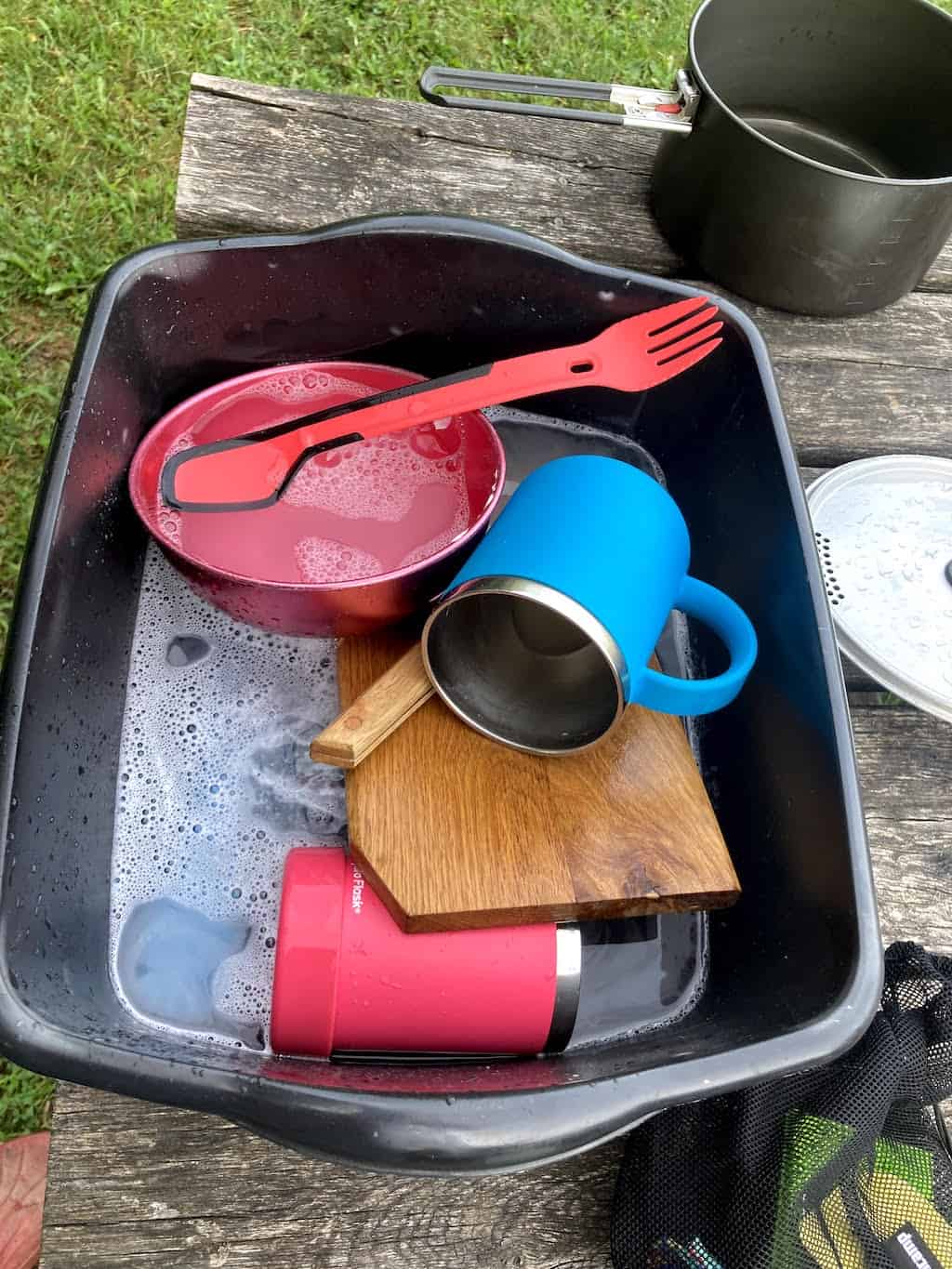How to Wash Dishes While Camping (and Have Fun Doing it)
Note: Advertising is how we keep this site free for you to enjoy, and we earn a commission from affiliate links that may be included in this post. Thank you for supporting Back Road Ramblers!
Camping is just about the best thing in the whole wide world, but what about washing dishes while camping?
I imagine it’s up there with using an outhouse in the middle of the night or waking up in a puddle after your tent leaked.

Washing dishes while camping will probably never be your favorite pastime, but there are steps you can take to simplify the process!
First, if you are the camp chef in your family, the first thing you need to do is establish a little dishwashing rule.
This is how it goes — whoever cooks the meal gets to relax while the rest of the crew takes care of the clean-up.
For our family, this rule has been in place since our kids needed a step stool to reach the sink, and it helps so much to have the whole family pitching in when we’re camping.
With or without helpers, it’s still important to know how to wash dishes while camping. It’s not difficult, but it is significantly different than washing dishes at home.
The secret ingredient for washing dishes while camping? A camp dishwashing station!
We’re going to dig into our much-tested dishwashing routine, followed by a bunch of tips to make the process as easy as possible, whether you’re camping with your extended family or on your own.
Dishwashing While Camping Using Leave No Trace Principles
Have you heard of Leave No Trace?
We try to follow Leave No Trace principles whenever we’re camping, whether we’re living it up in a rustic cabin, staying in a front-country campground, or roughing it in the backcountry.
You can read more about Leave No Trace principles in the link above, but I’ll summarize the bit that applies to washing dishes when camping.
Cook only the food you will realistically eat. Unless you have a cooler to preserve leftovers for the next meal, dealing with uneaten food is a pain in the butt. Cooking the perfect-sized portions takes practice, but the goal is to cook enough food to feed your family without having any leftovers.
If you do end up with leftovers, scrape your pots and pans into your campground dumpster. If you’re in the backcountry, you’ll have to double-bag it and pack it out. Leaving food near campsites attracts animals and encourages them to seek out humans when they are hungry. This rarely ends well for the wild animal that has now become a campground pest.
Wash camping dishes at least 200 feet away from streams, lakes, or other water sources. Dirty dish water can quickly pollute streams and lakes, even if you use biodegradable camp soap. Many campgrounds will require you to wash your dishes at your camp, not in common areas, and to do that, you’ll need a camping dishwashing station (we’ll talk about that more below).
Dispose of dishwater properly – Campgrounds will often have a sink or greywater disposal area to dump your dirty dishwater, but if not, strain your greywater and disperse it at least 200 feet away from your camp, trails, roads, and water sources.

Use biodegradable camping dish soap – No Dawn dish soap or any other products with polluting sulfites.
We have tried many different types of camping dish soap over the years, and we love Campsuds because it is multi-purpose and biodegradable.
We use just a few drops to wash the dishes, and we also use it to wash clothes and dirty hands. I usually buy a 2 oz. bottle at the beginning of each camping season, and it will often last through the summer. Also, the bottles are 100% leak-proof (very important) and reusable.
Create an Awesome Camping Dishwashing Station

Our camp dishwashing station comes with us on all of our car camping adventures and canoe trips, plus many short multi-day hikes. The system has changed very little over the 20+ years we’ve been using it.
When we’re backpacking, we often wash our dishes with just one small, portable bucket, and sometimes we wash our dishes with leaves and dirt (for real) and just use our collapsible dishwashing bucket for the final rinse.
If you’re curious about how to clean dishes while camping without water, the video below is a good overview. It gives a good overview of how to wash your dishes with dirt, although I wouldn’t rinse my dishes with bottled water as the video suggests.
What to Pack in Your Camp Dishwashing Station
Here’s the basic equipment you’ll need to wash dishes while camping. Our buckets/tubs have changed over the years, but the method is the same.
Two collapsible buckets or plastic tubs. You’ll need a bucket for washing dishes and one for rinsing. If you do mostly car camping, you can get away with any plastic tubs that will nest together and hold water.
If you think you’ll need something more portable for hiking and backpacking, opt for lightweight, collapsible buckets that will fit handily in your backpack. These Sea to Summit Kitchen Sinks are lightweight, portable, and come with a small stuff sack. You can get them in three sizes based on your needs.
We use one of these portable sinks for washing dishes, and then we hang the rinse water from a tree in this Sea to Summit Ultra-Sil Folding Bucket. This thing is so useful — a folding bucket that fits in the palm of your hand!
We like to have the rinse water set up all the time so we can use it as needed, and if we left it on the ground, the dog would knock it over or fill it with dirt and fur.
Rope. If you want to hang your rinse water, you’ll need a good piece of rope or paracord. This is also a good time to practice your knots.
A washcloth and towel. For cleaning up, grab one of these scrub and scrape camp kitchen cleaning kits, which includes a sponge, scraper, and washcloth. For drying, use a small, microfiber towel.
A strainer. A small strainer is awesome for capturing food from your dish water before you toss it into the woods. It’s important to do this because if you’ve got food mixed into your dish water, it will certainly attract animals when you dump it in the woods.
A Step-by-Step Guide: How to Wash Dishes While Camping

Now for the fun part! Here’s our step-by-step guide to washing dishes while camping.
- Crack a beer — or another indulgent beverage — and prepare your easy camping meal.
- After you plate up the food, but before you eat, fill your cook pot with water and let it sit near your campfire (on the edge of the grill works if your fire isn’t too big). This will make your dishwashing water tolerably warm. It will also keep the food from sticking. If you used your frying pan, add a bit of water to that as well and let it sit.
- Enjoy your awesome camp food. This is obviously the easy part, so relax!
- When dinner is over, fill up one bucket with cold rinse water. If you are anything like my husband, you will have done this upon arriving at camp.
- Add a few drops of ultra-concentrated biodegradable dish soap to your second bucket and fill it halfway with cold water. Add some of the hot water from your cook pot.
- Convince your kids to wash the camping dishes following the steps below.
- Add the silverware to the soapy water to soak. Now, immerse each dirty dish one at a time, starting with the cleanest dishes and moving on to the cookpots and dishes with stuck-on food.
- After washing each dish, dip it in clean rinse water.
- Hand it to the designated dryer, or if you are flying solo, stack the clean dishes on a rock, stump, picnic table, etc., where they’ll stay clean.
- Dry the dishes with your microfiber towel and put them away until the next meal.
- Disperse your bucket of rinse water 200 feet from your campsite. Spread the water far and wide to minimize the impact. Ignore this step if your campground has a designated disposal area for dish water.
- Now strain your soapy water into your empty bucket and disperse it in the same way.
- Throw away your food waste from the strainer, or pack it out.
A Few Tips for Making Dishwashing While Camping Easier

Nobody really wants to spend time washing dishes while camping, and over the years, we’ve been able to streamline our system by following a few simple tips:
Go vegetarian. We find that cooking meat just makes a mess and attracts animals. A greasy pan quickly mucks up the dish water, and then the pancakes end up tasting like burgers. We almost always cook vegetarian while camping. For the die-hard meat eaters, we bring jerky, pepperoni, and tuna fish, which are usually eaten straight out of the package.
Use bread to clean your plate after eating. Isn’t this the best use of bread anyway? You can sop up all the delicious sauce, soup, or flavoring to make washing easier.
Don’t burn your camp food! You know what they say about an ounce of prevention and all that. When you’re cooking your camp food, don’t take your eyes off the pot. Add more water than you think you need, and stir frequently. A burned pot is the worst when camping.
Please don’t use disposable tableware. Believe me, I know it’s tempting, but as outdoor lovers, we owe it to our one and only earth to tread lightly and reduce our impact. Washing up isn’t that bad!
Don’t let the thought of washing dishes while camping keep you from enjoying the outdoors. Once you have a system in place, you won’t think twice about it.
For more camping tips, check out these posts:
- Create a DIY Camping Spice Kit
- Your Amazing Car Camping Kitchen
- Making the Perfect Cup of Camping Coffee
- Camping Pancakes: 7 Recipes from One Basic Mix
Follow us on social media for more camping ideas!






